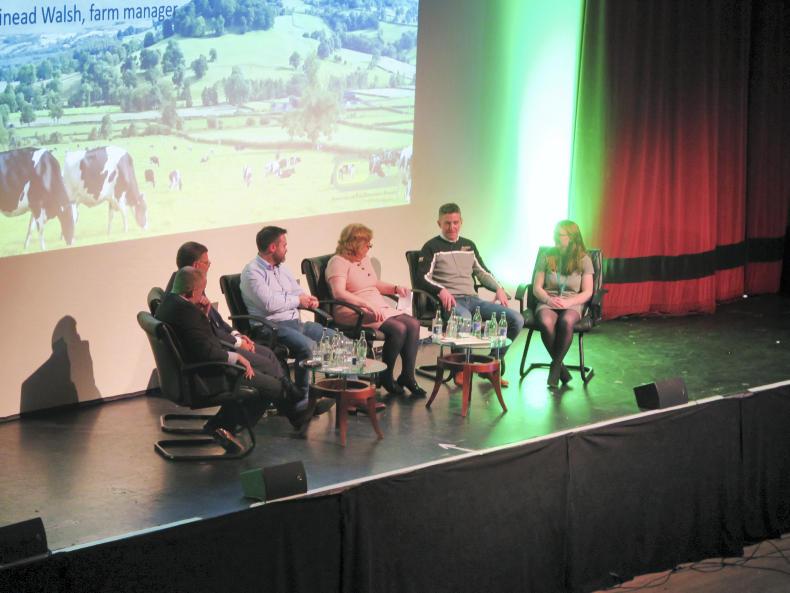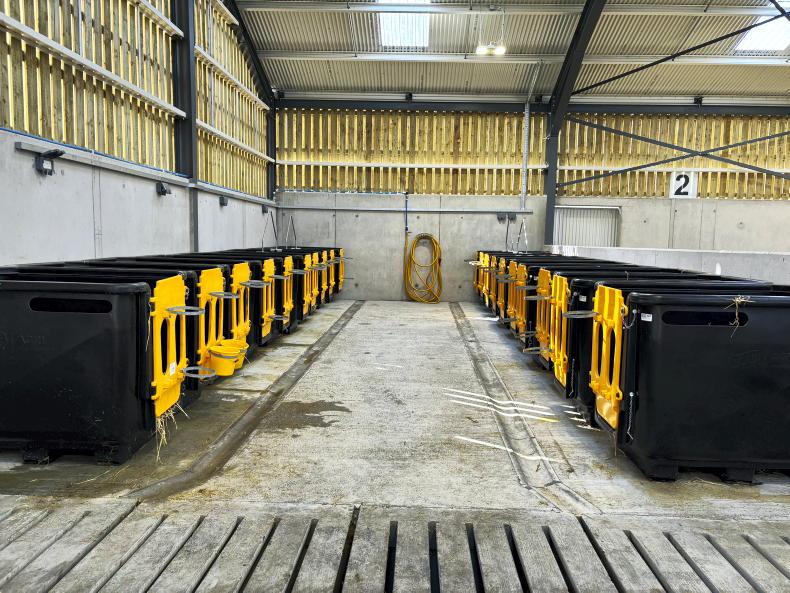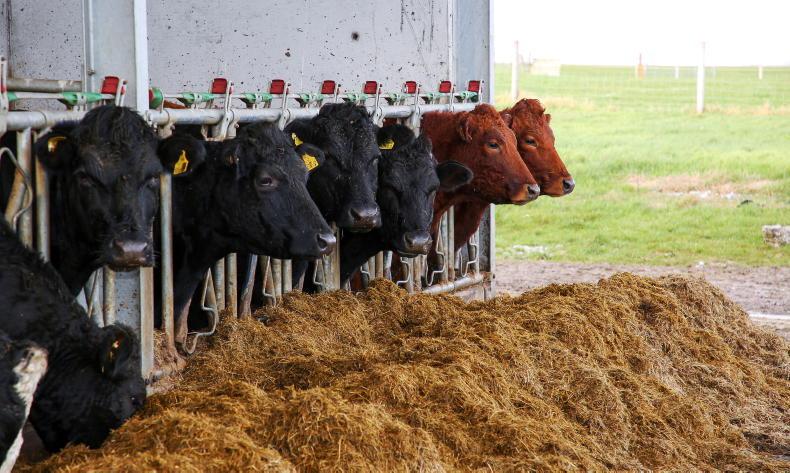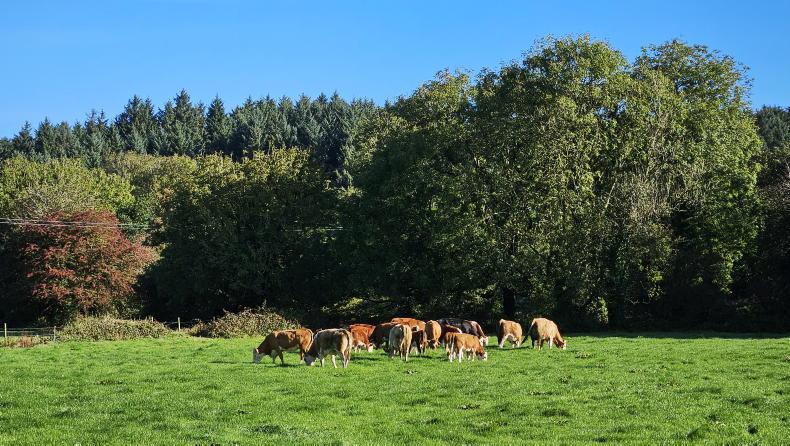When Frank Coffey took over the family farm in Killeentierna, near Farranfore, in 1994, he was milking 40 cows on 48 acres. His ambition was to be a “big farmer” and milk 100 cows. In order to achieve that goal he needed to increase the land area. As he was surrounded by dairy farmers, he had to rent land away from the home block.
“It was all running and racing, bringing silage in and slurry out. It took an hour a day to check cattle when things went well, but it could be six hours if things went wrong,” Frank says.

Frank Coffey speaking at the Teagasc National Dairy Conference.
In 1999, the Coffeys’ lives were turned upside down when Frank’s brother died from cancer aged 33. The following year his father also died from cancer and two years later the herd was wiped out with BSE. The three events were a catalyst for Frank to take a step back and analyse what he was at. He says his work-life balance was tipped in favour of work, but he wanted to have more time for living.
The extra land he was leasing allowed him to increase cow numbers to 50. After being depopulated with BSE, he had to buy in a new herd. He says now that the cows he bought were the wrong type of cow for the system he wanted to run;
“I bought back 40 high-yielding Holstein Friesian cows. They were big cows with big yields and they cost big money.
“They were all calved by 17 March in the first year so we got off to a great start. The thing I noticed about them though was that they didn’t like having calves.
I was calving at the same time as breeding
“The six-week calving rate went from 100% to 60% by year two. Then in order to hang on to the late-calving cows I started milking them over the winter. There was no structure to the work. I was calving at the same time as breeding. It just wasn’t suiting me.”
Extra land came on stream in 2006 when 38 acres were leased next door to the farm.
Then, in 2008, Frank got the opportunity to purchase 18 acres and in 2010 another 24 acres was leased next to this purchased land, bringing total land farmed to 128 acres today. Frank is now living the dream with 104 cows being milked.
However, the goal in terms of cow numbers was only half of Frank’s overall goal. He didn’t want the farm to take from family time. Married to Siobhan, they have four children who are all mad into sport. Frank got involved in the GAA club and managed the under-12 football team when eldest son Gearoid was on it.
If it took me an hour and a half to milk, it meant I needed to go for the cows at 3.30pm
“The under-12 matches were always on at 6pm in the evenings, meaning there would be 25 kids waiting for me in the bus at 5pm. That meant I needed to have the cows milked before then so I just worked backwards.
“If it took me an hour and a half to milk, it meant I needed to go for the cows at 3.30pm, or 3pm if the cows were in a far-away paddock,” Frank says.
Extra land
While the extra land allowed Frank to expand the herd, achieving this goal of more cows would have been counterproductive if it meant he hadn’t the time to attend games and matches and go on holidays with the family.
He describes trying to run a simple grass-based block calving system with the high-yielding cows as akin to digging a grave with a pitchfork – it just wasn’t working.
In 2010, some members of the CFS discussion group of which he is a member of decided to go crossbreeding with Jersey cows. Frank says it has changed his farm inside out. Within four years, the six-week in-calf rate went from 61% to 90% and his calving and breeding periods are more defined, allowing him to take a holiday during the “breather” period in April.
The 20 yearling heifers are all contract-reared, further reducing the workload
Asked whether he would go crossbreeding now, considering that the black and white cow has improved greatly over the last decade, he said he would: “The smaller cow suits my farm. The crossbred cow is the ideal cow for Kerry,” Frank says.
All slurry spreading is carried out by a contractor, with fertiliser spread by a contractor in spring also.
“The 20 yearling heifers are all contract-reared, further reducing the workload. A new parlour was built in 2016, so milking takes less than an hour, with Gearoid doing four or five milkings a week.
“The spring is busy but we cope well. I find that having enough calf housing is critical. Not having enough space is a nightmare as it leads to more health problems and there’s no harder work than dealing with sick calves.
“One of the things that really reduced the workload on the farm has been woodchip. It completely changed the labour needed in spring.
“I put a foot of woodchip in the calving pen at the start and only have to change it after all the cows are calved. We put woodchip under the calves also and put straw on top and it works great.”
Asked if he has plans to expand the herd further, Frank says that getting to 100 cows has been his dream. Increasing cow numbers further would require more investment in the yard and facilities.
“I’ve achieved my goals. I think I’ll leave space for someone else to achieve their goals,” Frank says.
Lean farming: reducing working times on farms
Teagasc researcher Marion Beecher spoke about how lean work practices can reduce working times on farms. She used the example of Aidan Ahearne from Dungarvan in Co Waterford.
Aidan and his team in Cappagh are milking 207 cows through a 16-unit parlour.
Marion says milking 13 rows through a parlour is on the high side, with the recommendation being seven to eight rows and a maximum of 1.5 hours milking.
Marion and her colleagues from Teagasc evaluated the milking routine on the farm. On their first visit, the whole milking process took three hours. They recommended a number of changes to the routine including:
Removing a blind corner in the collecting yard to improve cow flow.Hanging gates to make the collecting yard smaller when needs be.Replacing teat spray bottles with droppers.Storing essential items in the milking pit.De-clutter the dairy and plant room.Keep water hoses tidy.Clean parlour and yards immediately after milking.Identify slow milkers and attach clusters to them first.In their first evaluation, Aidan left the pit 14 times for various reasons. After implementing the changes, the time spent on the milking process reduced by 16 minutes per milking or 32 minutes per day, with Aidan only leaving the pit six times.
By right, the milker shouldn’t have to leave the pit at all. Over the course of the week, Aidan saved almost four hours by implementing lean practices in just one area of the farm.
Farming 128 acres with 62 rented.Milking 104 Jersey crossbred cows.Produced 490kgMS/cow in 2019.Feeding 700kg of meal. 20 replacement heifers.
Read more
Dairy management: should you dose dry cows for fluke?
Spotlight on nitrogen for dairy farmers
When Frank Coffey took over the family farm in Killeentierna, near Farranfore, in 1994, he was milking 40 cows on 48 acres. His ambition was to be a “big farmer” and milk 100 cows. In order to achieve that goal he needed to increase the land area. As he was surrounded by dairy farmers, he had to rent land away from the home block.
“It was all running and racing, bringing silage in and slurry out. It took an hour a day to check cattle when things went well, but it could be six hours if things went wrong,” Frank says.

Frank Coffey speaking at the Teagasc National Dairy Conference.
In 1999, the Coffeys’ lives were turned upside down when Frank’s brother died from cancer aged 33. The following year his father also died from cancer and two years later the herd was wiped out with BSE. The three events were a catalyst for Frank to take a step back and analyse what he was at. He says his work-life balance was tipped in favour of work, but he wanted to have more time for living.
The extra land he was leasing allowed him to increase cow numbers to 50. After being depopulated with BSE, he had to buy in a new herd. He says now that the cows he bought were the wrong type of cow for the system he wanted to run;
“I bought back 40 high-yielding Holstein Friesian cows. They were big cows with big yields and they cost big money.
“They were all calved by 17 March in the first year so we got off to a great start. The thing I noticed about them though was that they didn’t like having calves.
I was calving at the same time as breeding
“The six-week calving rate went from 100% to 60% by year two. Then in order to hang on to the late-calving cows I started milking them over the winter. There was no structure to the work. I was calving at the same time as breeding. It just wasn’t suiting me.”
Extra land came on stream in 2006 when 38 acres were leased next door to the farm.
Then, in 2008, Frank got the opportunity to purchase 18 acres and in 2010 another 24 acres was leased next to this purchased land, bringing total land farmed to 128 acres today. Frank is now living the dream with 104 cows being milked.
However, the goal in terms of cow numbers was only half of Frank’s overall goal. He didn’t want the farm to take from family time. Married to Siobhan, they have four children who are all mad into sport. Frank got involved in the GAA club and managed the under-12 football team when eldest son Gearoid was on it.
If it took me an hour and a half to milk, it meant I needed to go for the cows at 3.30pm
“The under-12 matches were always on at 6pm in the evenings, meaning there would be 25 kids waiting for me in the bus at 5pm. That meant I needed to have the cows milked before then so I just worked backwards.
“If it took me an hour and a half to milk, it meant I needed to go for the cows at 3.30pm, or 3pm if the cows were in a far-away paddock,” Frank says.
Extra land
While the extra land allowed Frank to expand the herd, achieving this goal of more cows would have been counterproductive if it meant he hadn’t the time to attend games and matches and go on holidays with the family.
He describes trying to run a simple grass-based block calving system with the high-yielding cows as akin to digging a grave with a pitchfork – it just wasn’t working.
In 2010, some members of the CFS discussion group of which he is a member of decided to go crossbreeding with Jersey cows. Frank says it has changed his farm inside out. Within four years, the six-week in-calf rate went from 61% to 90% and his calving and breeding periods are more defined, allowing him to take a holiday during the “breather” period in April.
The 20 yearling heifers are all contract-reared, further reducing the workload
Asked whether he would go crossbreeding now, considering that the black and white cow has improved greatly over the last decade, he said he would: “The smaller cow suits my farm. The crossbred cow is the ideal cow for Kerry,” Frank says.
All slurry spreading is carried out by a contractor, with fertiliser spread by a contractor in spring also.
“The 20 yearling heifers are all contract-reared, further reducing the workload. A new parlour was built in 2016, so milking takes less than an hour, with Gearoid doing four or five milkings a week.
“The spring is busy but we cope well. I find that having enough calf housing is critical. Not having enough space is a nightmare as it leads to more health problems and there’s no harder work than dealing with sick calves.
“One of the things that really reduced the workload on the farm has been woodchip. It completely changed the labour needed in spring.
“I put a foot of woodchip in the calving pen at the start and only have to change it after all the cows are calved. We put woodchip under the calves also and put straw on top and it works great.”
Asked if he has plans to expand the herd further, Frank says that getting to 100 cows has been his dream. Increasing cow numbers further would require more investment in the yard and facilities.
“I’ve achieved my goals. I think I’ll leave space for someone else to achieve their goals,” Frank says.
Lean farming: reducing working times on farms
Teagasc researcher Marion Beecher spoke about how lean work practices can reduce working times on farms. She used the example of Aidan Ahearne from Dungarvan in Co Waterford.
Aidan and his team in Cappagh are milking 207 cows through a 16-unit parlour.
Marion says milking 13 rows through a parlour is on the high side, with the recommendation being seven to eight rows and a maximum of 1.5 hours milking.
Marion and her colleagues from Teagasc evaluated the milking routine on the farm. On their first visit, the whole milking process took three hours. They recommended a number of changes to the routine including:
Removing a blind corner in the collecting yard to improve cow flow.Hanging gates to make the collecting yard smaller when needs be.Replacing teat spray bottles with droppers.Storing essential items in the milking pit.De-clutter the dairy and plant room.Keep water hoses tidy.Clean parlour and yards immediately after milking.Identify slow milkers and attach clusters to them first.In their first evaluation, Aidan left the pit 14 times for various reasons. After implementing the changes, the time spent on the milking process reduced by 16 minutes per milking or 32 minutes per day, with Aidan only leaving the pit six times.
By right, the milker shouldn’t have to leave the pit at all. Over the course of the week, Aidan saved almost four hours by implementing lean practices in just one area of the farm.
Farming 128 acres with 62 rented.Milking 104 Jersey crossbred cows.Produced 490kgMS/cow in 2019.Feeding 700kg of meal. 20 replacement heifers.
Read more
Dairy management: should you dose dry cows for fluke?
Spotlight on nitrogen for dairy farmers











SHARING OPTIONS